We grow our own food in a suburban village in the North East of England. Follow us as we keep up the battle to be self-sufficient.
Wednesday 28 October 2009
An autumn task
Rake up the leaves in the autumn and put them in plastic sacks. If you want to be super-environmentally conscious, use the sacks that constantly get posted through your door by charities collecting clothes. Black bin liner bags are just as good (if not better as they don't let in the light so easily). Tie the filled sack closed and stack them up. Leave them where there are out of sight - they need to stand for a year. It will take that time for the leaves to rot down to a first class compost and soil conditioner.
Fill plenty of sacks as this stuff condenses right down. Aim for enough to avoid having to waste money on bags of compost. Mind you, try not to spread the finished product all over your large allotment beds. Use manure on them instead. The leaf mould I will be making shortly will be for use in bags and pots.
---
Sent via BlackBerry
Tuesday 27 October 2009
Apple jelly
Yesterday I ended up with a large quantity of cores and peel created from bottling apples. There are various options for using up this waste. If you have lifestock, it is a great feed. Alas, I have no livestock (yet). Instead, I put it all into a pan and boiled it then strained it overnight. The resulting liquid can then be made into a jelly, a job I shall carry out later today. I am actually going to make a spiced jelly for Christmas.
Photos and opinion on how it all went will be posted up within the next 24 hours.
Incredible shrinking apples
This is not the first time I have bottled fruit. A few weeks ago I bottled the plums from the allotment and more recently I bottled pears I picked on a derelict orchard near Sunniside. Last year I bottled apples (in jam jars!) So, I expected today to be straightforward. In a sense it was. What I didn't expect was the extent to which the apple shrank. I think I may have stewed them a bit too long.
Tomorrow I will do some more but cook them for less time.
---
Sent via BlackBerry
Sunday 25 October 2009
Pick the sweetcorn now!
Sunday 18 October 2009
Bean slicer
It's from Lakeland Plastics. Here's the link the the product:
http://www.lakeland.co.uk/F/keyword/runner%20bean%20slicer
Generally I find it a useful product, the two drawbacks are that it does not often remain fixed to a work surface and its base stops you from putting a collecting tray or plate conveniently below the blades. You can get an idea from the photo below of David chopping beans.

Nevertheless, I would recommend it, especially if you grow lots of runner beans. It does make the job of dealing with large quantities much easier. It's currently selling at £19.77.
And to illustrate the point.....
Before:
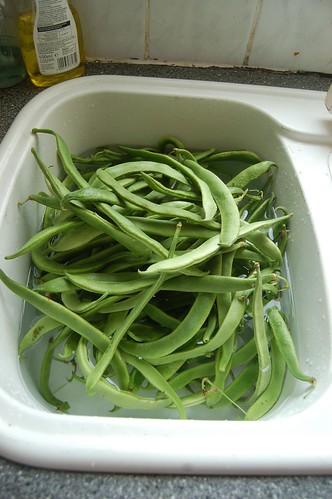
After:
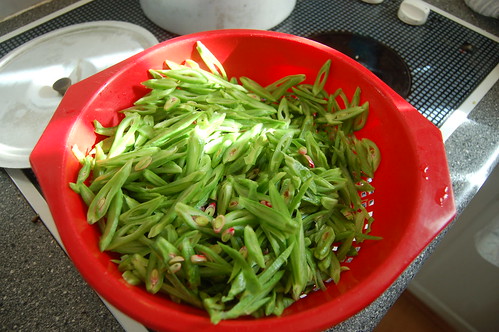
And just because I feel very proud of my runner bean crop this year!:
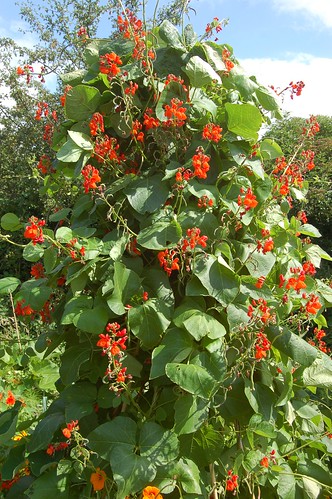
And don't forget our video on how to preserve runner beans: http://www.youtube.com/watch?v=Oh9u5A8vuvI
Friday 16 October 2009
Sweetcorn
Wednesday 14 October 2009
Hawberry ketchup
Hawthorn is one of our most common hedgerow trees. In the spring it is covered in white flowers. In the autumn it sags under the eight of bunches of small, bright red berries which are great for making jellies and, in this instance, ketchup. Hawberry ketchup has a fruity but sweet and sour taste to it. It's great to eat and easy to make. The abundance of the berries makes it a good one to try for the occasional food forager.
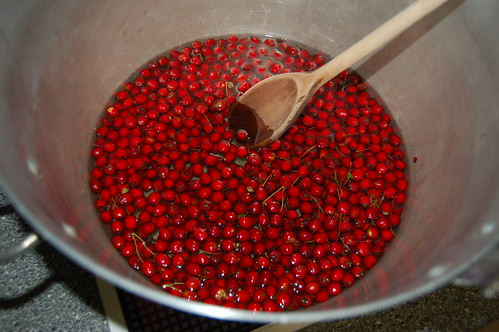
What to do:
Rinse 500g of berries and put into the pan with 300 ml of white wine vinegar and 300ml of water.
Bring to the boil then simmer until all the berries have broken up and pulped. This takes at least half an hour.
Use a potato masher to break up the pulp ever more then press it through a sieve. Throw the stalks, skin and pips into the compost bin and then return the puree to the (now cleaned) pan.
Reheat the pan and stir in about 160-180g of sugar. Add about a half to whole teaspoon of salt and then ground black pepper to taste. At this stage if you want to, add in some spices. I added a splash of cayenne pepper.
Bring back to boil and simmer for around 5 minutes, then add to sterilised bottles.
This stuff can keep for about a year but once opened, it's best to keep in the fridge. All the books etc I have read say it is good with cold meats. I used mine as a dip for cheese which was pleasant.
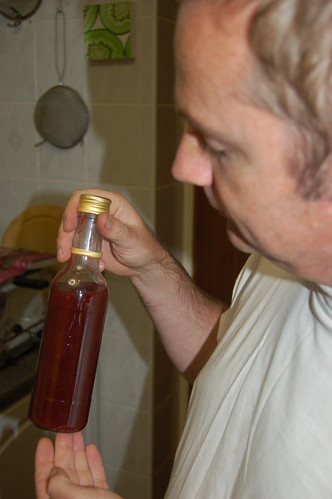
Note the rather pleasant colour to it. Anyway, here's the video we filmed on how to make hawberry ketchup:
The recipe we used is based on the one in the River Cottage Handbook No. 2 on Preserves by Pam Corbin with an introduction by Hugh Fearnley-Whittinstall (who else!?)
Salting runner beans

Yes, I know, salt is the must-avoid ingredient nowadays. The reality is, it is a must-avoid if you are eating a diet mainly of processed foods stuffed full of sugar, fats and, of course, salt. Yes, it is right to avoid eating too much. However, if your diet is based on healthy, home grown foods, salt is much less of an issue.
And once salted beans have been prepared for cooking, most of the salt is lost anyway.
To prepare beans for salting, chop them after rinsing them. In a jar place a layer of salt. On top of it add a layer of chopped beans, then another layer of salt and so on til the jar is full. Close the lid.
You will rapidly see the salt turn to brine as it draws out the moisture from the beans. Store the beans in a cool dry cupboard, wrapped in brown paper to keep off any light, which can cause the beans to discolour.
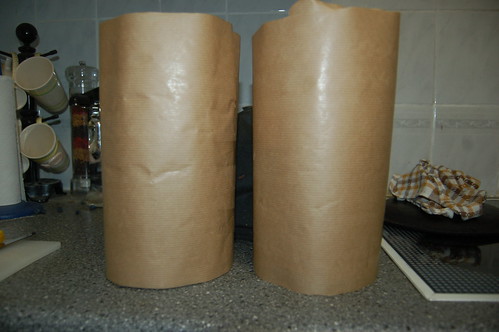
To use the beans, rinse them and steep them in warm water for about 45 minutes. Then cook.
Thursday 8 October 2009
Red cabbage
Meanwhile, at the end of September, with bed one cleared of the broad beans and bed 5 of the potatoes, we planted out winter cabbages. We grew them from seeds in the greenhouse and have a surplus of plants which are going to Dad's allotment up the road in Marley Hill village.
We are expecting arrival of our winter garlic as well soon. Given the fantastic crop we have had from the bulbs we planted last year, this is definitely a crop we are wanting to repeat.
Thoughts turning to Xmas dinner
Wednesday 7 October 2009
How to preserve runner beans
Unlike last year, our runner bean crop this year has been a great success. In this video I explain how to preserve them in two different ways, by freezing and by salting.
Saturday 3 October 2009
Hazel nuts
This week I have picked about 4-5kg. They are stored in a hessian sack in the garage. Watch out for my recipes and videos on how to use them.
---
Sent via BlackBerry
Thursday 1 October 2009
How to pickle nasturtium seeds
Nasturtium seeds when pickled make a great ingredient for use in soups and sauces. Raw or pickled they are great in salads. This is how we pickle them.
The whole plant can be used. It has an enjoyable peppery taste.